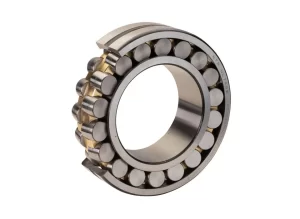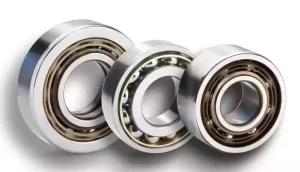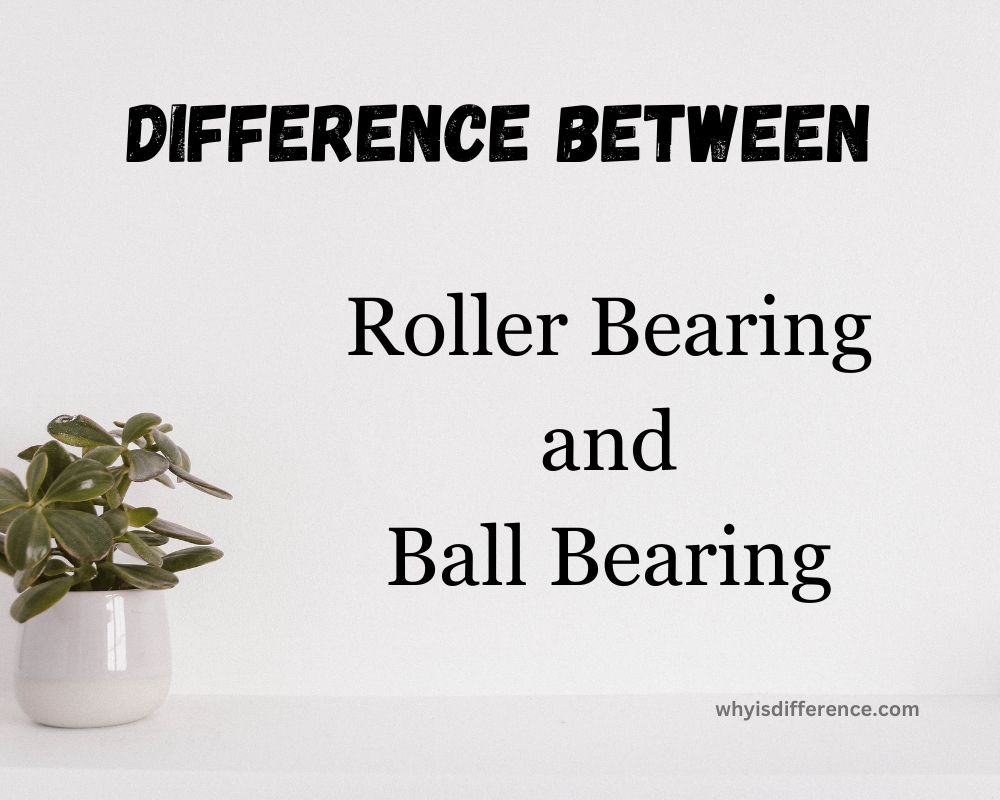Roller Bearing and Ball Bearing: Bearings are objects used to reduce friction when moving two surfaces that move or rotate, providing smoother motion and reduced friction. Bearings have been around since ancient civilization; prior to modern bearings' invention, people relied on other means for this task - including rocks. Bearings can be classified according to size, shape, and motion capability as well as load bearing capacity; two commonly-used bearing types include ball and roller bearings and this article will explore the differences between them.
Definition of Bearings
Bearings are mechanical components designed to facilitate smooth, controlled motion between multiple parts. Their purpose is to support moving parts while also minimizing frictional resistance between moving components allowing them to rotate or move with minimum resistance. Bearings typically consist of an inner ring, outer ring, rolling elements (such as balls or rollers) held within their cage, as well as their installation within machines, automotive systems, aerospace or industrial equipment which involve rotational or linear movement - they play an essential part in transmitting loads efficiently while providing reliable movement across mechanical systems of any size or complexity.
Importance of bearings in various applications
Bearings play an essential role in various applications due to their role in providing smooth and efficient movement.
Some key reasons bearings are essential across various fields include:
- Reduced Friction: Bearings are designed to reduce friction between moving parts and enable smooth rotation or movement, helping reduce energy waste while increasing overall system efficiency. By doing this, bearings help minimize energy loss while also improving system effectiveness.
- Load Support: Bearings provide load support by evenly distributing forces imposed upon rotating or moving parts, helping prevent excessive wear and damage while simultaneously increasing the lifespan and reliability of components.
- Precision and Accuracy: Bearings offer accuracy and control in applications requiring precise movement or positioning, like machine tools and robotics. Their smooth rotation or linear movement contributes to overall system precision.
- Noise Reduction: Bearings with low friction characteristics contribute to quieter operation by minimizing noise and vibration generation, making them especially suitable for applications where noise reduction is essential, such as household appliances, automotive systems, and industrial machinery.
- Increased Speed and Efficiency: Bearings increase rotational or linear speeds by reducing friction and providing smooth motion, making them essential components in applications requiring fast yet efficient operations such as high-speed machinery, automotive engines, and aerospace systems.
- Versatility and Adaptability: Bearings can be found in various shapes, sizes, materials, and types to suit specific application needs. For instance, bearings can be designed to withstand extreme temperatures, corrosive environments, high loads, or specific operational conditions to make them suitable for various industries and applications.
- Maintenance and Cost Savings: Selecting and maintaining bearings correctly can contribute to lower maintenance costs and downtime, by providing smooth operation with minimal wear on other components and prolonging their lives for less frequent replacement and reduced associated costs.
Bearings are key components in many applications, providing efficient, reliable, and precise movement while simultaneously reducing friction, wear, and energy consumption. Their importance lies in optimizing performance while prolonging equipment lifespan and optimizing productivity across industries.
Roller Bearings

Roller Bearings are a type of bearing that uses cylindrical or tapered rolling elements to enable smooth rotation and movement between two or more parts. Roller bearings are commonly utilized across various industries due to their ability to support heavy loads while withstanding high radial and axial forces, making them popular choices.
Here are some key aspects of roller bearings:
Definition and Components: Roller bearings consist of inner and outer rings, rolling elements (rollers) that move inside, as well as a cage that houses them all. Rolling elements typically take the shape of cylindrical or tapered rollers.
- Types of Roller Bearings
- Cylindrical Roller Bearings: These bearings feature cylindrical rolling elements which offer increased radial load capacity. Common applications for them include electric motors and machine tools that place predominant radial loads.
- Tapered Roller Bearings: Tapered roller bearings feature conical rolling elements which can handle both radial and axial loads, often used in pairs or sets to support opposing forces in both directions. Tapered roller bearings can often be found in automotive wheel assemblies and heavy machinery applications.
- Spherical Roller Bearings: Spherical roller bearings feature barrel-shaped rolling elements and can easily accommodate misalignment and shaft deflection, making them suitable for applications involving high radial loads but moderate axial loads, such as mining equipment or paper mills.
- Working Principle: Roller bearings operate using rolling contact. Rolling elements (rollers) reduce friction between inner and outer rings for smooth rotation. A cage keeps all rollers at a uniform spacing to maintain proper alignment and avoid collision between adjacent rollers.
Advantages of Ball Bearings
- a. Roller bearings offer superior load capacities due to their larger contact surface area, enabling them to better bear heavy radial and axial loads than ball bearings.
- Roller bearings offer greater radial and axial stiffness, making them suitable for applications that demand rigidity and precision.
- Roller bearings are specially engineered to withstand heavy loads and shocks, making them suitable for demanding applications in industries like construction and mining.
Applications of Roller Bearings
- a. Automotive Industry: Roller bearings can be found in wheel assemblies, transmission systems, engines, and suspension components of automotive vehicles.
- b. Industrial Machinery: Industrial machinery can be found in machine tools, printing presses, conveyor systems, and heavy-duty equipment.
- c. Construction Equipment: Roller bearings can be found in construction equipment like cranes, excavators, and bulldozers.
Roller bearings are versatile and reliable components that offer reliable support and load-carrying capacities in a range of applications, particularly those involving heavy loads and challenging operating conditions.
Ball Bearings

Ball bearings are a type of bearing that utilize spherical or cylindrical rolling elements known as balls for smooth rotation between multiple parts, providing minimal friction, high rotational speeds, and the capacity to support both radial and axial loads.
Here are some key aspects of ball bearings:
Definition and Components: Ball bearings consist of an inner and outer ring, rolling elements (balls), and a cage to secure them all together. Rolling elements typically are composed of steel or ceramic, featuring smooth, spherical, or cylindrical surfaces with uniform texture for efficient rolling performance.
- There are various types of ball bearings, including:
- Deep Groove Ball Bearings: Deep groove ball bearings feature deep raceway grooves on both inner and outer rings to support radial, axial, and combined loads. As one of the most common ball bearings used across numerous applications, deep groove ball bearings have proven invaluable in many situations.
- Angular Contact Ball Bearings: Angular contact ball bearings feature raceways on both inner and outer rings to support combined axial and radial loads. They are particularly well suited to applications involving high-speed rotation with precise axial positioning requirements, such as machine tool spindles or automotive wheel hubs.
- Thrust Ball Bearings: Thrust ball bearings are designed to withstand predominantly axial loads. Consisting of two grooved washers connected by balls arranged between them, thrust ball bearings are commonly found in automotive transmissions and thrust reversers in aircraft engines where high load capacities are necessary.
- Working Principle: Ball bearings work on the principle of rolling contact. Rolling elements (balls) reduce friction between inner and outer rings for smooth rotation while their cage maintains uniform spacing to maintain proper alignment without collision between adjacent balls.
- Benefits of Ball Bearings
- a. Reduced Friction and Heat Generation: Ball bearings offer lower coefficients of friction than roller bearings, leading to decreased heat generation and energy loss.
- b. Higher Rotational Speeds: Thanks to their low friction properties, ball bearings can achieve higher rotational speeds than many other bearings available - making them suitable for applications requiring fast and precise movement.
- Smoother Operation and Lower Noise Levels: Ball bearings feature rolling contact between balls to achieve smoother operation while reducing vibration levels and noise pollution levels.
- Application of Ball Bearings
- Electric Motors: Ball bearings are widely utilized in electric motors, both inside the motor itself as well as various rotating components like fans and pulleys.
- Machine Tools: They are utilized in machine tool spindles, linear motion systems and precision positioning equipment.
- Household Appliances: Ball bearings can be found in household appliances like washing machines, refrigerators, and vacuum cleaners.
Ball bearings are widely utilized due to their efficiency, high-speed capacities, and versatility in supporting both radial and axial loads. Their smooth operation, low friction levels, and ability to handle an array of applications make them integral components in numerous industries.
Key Difference Between Roller Bearing and Ball Bearing
Both ball and roller bearings possess important differences that can be summarized as follows:
- Design and Shape: The primary difference lies in their respective designs and shapes of rolling elements; roller bearings utilize cylindrical or tapered rollers while ball bearings use either spherical or cylindrical balls as rolling elements.
- Load Capacity: Roller bearings typically offer greater load-carrying capacity compared to ball bearings due to their larger contact surface area and ability to distribute loads more effectively, making rollers ideal for applications involving heavy radial or axial loads.
- Friction and Heat Generation: Ball bearings typically exhibit lower friction and heat production due to their direct point contact with raceways; roller bearings feature line contact between their balls and raceways, potentially increasing friction and heat generation slightly.
- Rotational Speeds: Ball bearings have the capability to achieve higher rotational speeds than roller bearings due to their smaller size and reduced friction - perfect for high-speed applications!
- Noise Reduction and Smooth Operation: Ball bearings typically offer smoother operations with reduced vibration and noise levels than roller bearings, due to point contact between balls reducing vibration and sound levels.
- Applications: Roller bearings are often the preferred solution in applications that involve heavy machinery, construction equipment and automotive systems that require high load capacities. Ball bearings, however, tend to be used more commonly for electric motors, household appliances, machine tools or any other applications which prioritize high speeds with smooth operation and low noise emissions.
- Cost Considerations: Roller bearings tend to be more costly than ball bearings due to their larger size and higher load capacities; however, costs can differ based on factors like size, quality, and application needs.
Notably, selecting roller bearings vs. ball bearings depends upon a host of variables including load conditions, rotational speeds, precision needs, cost considerations and more. Each bearing type offers advantages that meet specific industry performance demands.
Comparison Table:
| Aspect | Roller Bearings | Ball Bearings |
|---|---|---|
| Rolling Elements | Cylindrical or Tapered Rollers | Spherical or Cylindrical Balls |
| Load Capacity | Higher | Lower |
| Friction and Heat | Slightly Higher | Lower |
| Rotational Speeds | Lower | Higher |
| Noise and Smoothness | Moderate | Smoother, Lower Noise |
| Applications | Heavy Machinery, Automotive | Electric Motors, Machine Tools, |
| Systems, Construction Equipment | Household Appliances | |
| Cost | Generally Higher | Generally Lower |
Conclusion
the primary difference between ball and roller bearings is in the design of their bearings and load-bearing capacity. Roller bearings use tapered or cylindrical rollers that distribute loads over a greater surface, making them suitable for handling large both axial and radial loads. However, ball bearings employ small, metal balls that reduce friction, which makes them suitable for radial loads lighter as well as high-speed applications. The selection between ball and roller bearings is based on the particular requirements of the specific application taking into consideration factors like the capacity of the load, speed, and the precision. Knowing the differences between these two types of bearings helps engineers and designers pick the best bearing for the best efficiency and performance in a variety of mechanical systems.

